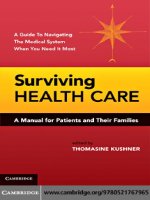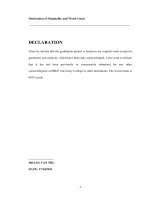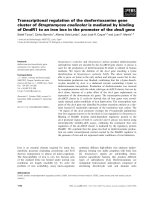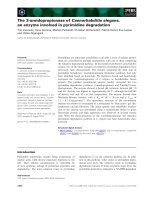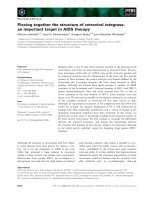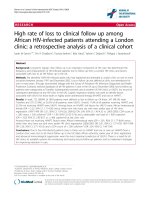Health care seeking behaviour of patients attending an STI clinic in singapore
Bạn đang xem bản rút gọn của tài liệu. Xem và tải ngay bản đầy đủ của tài liệu tại đây (1.77 MB, 120 trang )
HEALTH CARE SEEKING BEHAVIOUR OF PATIENTS
ATTENDING AN STI CLINIC IN SINGAPORE
DR THIYAGARAJAN JAYABASKAR
(M.B.B.S), (INDIA)
A THESIS SUBMITTED FOR THE DEGREE OF MASTER OF SCIENCE
DEPARTMENT OF COMMUNITY, OCCUPATIONAL AND
FAMILY MEDICINE
NATIONAL UNIVERSITY OF SINGAPORE
2003
ACKNOWLEDGEMENTS
This dissertation would not have been completed without the help and support, both
moral and material, of many persons. In particular, I am indebted to my supervisor
Associate Professor Wong Mee Lian for her expert guidance, encouragement and helpful
advice during the course of my study, especially supporting me through my difficult
times with understanding and care. I am grateful to Dr. Roy Chan, Head of the DSC for
encouraging me to pursue research and giving support during my research study. I would
like to mention Sharon Wee and convey my heartfelt thanks for her support throughout
the course of the study. The way of research that I have learned from them will greatly
benefit my career and life in the future.
I am also indebted to Dr Chan, CTERU for his comments for his guidance in the data
analysis. I wish to convey my heartfelt thanks to all staff and postgraduate students at
COFM, for their encouragement and help. Thanks are also due to staff and nurses of DSC
clinic.
I would also like to acknowledge the loving support of my parents and brothers. I would
also like to convey my thanks to my friend Ann. I would like to extend my thanks to
Allan for helping me in proof reading. Friends at NUS and back home who encouraged
and provided moral support and many helpful tips on survival, all of which are much
appreciated.
i
HEALTH CARE SEEKING BEHAVIOUR OF PATIENTS ATTENDING
AN STI CLINIC IN SINGAPORE
TABLE OF CONTENTS
Acknowledgements
i
Contents
ii
List of tables
v
List of figures
vi
Abstract
1
Chapter 1
Introduction
4
Chapter 2
Background
7
2.1
Sexually transmitted diseases
2.1.1 Epidemiology of Sexually transmitted infections (STIs)
2.1.2 Interaction between STIs and HIV/AIDS
2.1.3 Impact of STIs
2.1.4 Impact of HIV/AIDS
Chapter 3
2.2
Interventions to prevent HIV infection
2.3
Sexual networks – Core groups
2.4
Overview of STIs / HIV/AIDS in Singapore
2.4.1
Epidemiology of STIs in Singapore
2.4.2
Trends in STIs in Singapore
2.4.3
Sexual behaviour in Singapore
Literature review
20
3.1 Health seeking behaviour
3.2 Measuring Healthcare-seeking behaviour
3.3 Cues for health seeking behaviour
3.4 Factors influencing health seeking behaviour
ii
3.5 Barriers to Healthcare-seeking behaviour
3.6 Significance of promoting health care seeking-behaviour
in control of STIs
3.7 Significance of the study
Chapter 4
Methodology
38
4.1 Study design
4.2 Sampling and sample
4.3 Inclusion/exclusion criteria
4.4 Survey tool /questionnaire
4.5 Data collection
4.6 Procedure
4.7 Measures and data reduction
4.8 Data analysis
Chapter 5
Results
46
5.1 Description of Study population
5.1.1 Sociodemographic features of the sample
5.1.2 Clinical presentation of symptoms
5.1.3 STI knowledge in the sample
5.2 Delay in health care-seeking behaviour by sociodemographic variables
5.3 Delay in health care-seeking behaviour by
knowledge of STIs
5.3.1 STI knowledge score
5.4 Delay in health care-seeking behaviour by sexual behaviour
of STI patients
5.5 Delay in health care-seeking behaviour by perceived
severity of, and vulnerability towards, STIs
iii
5.6 Delay in health care-seeking behaviour by self-reported
symptoms
5.7 Delay in health care-seeking behaviour by behavioural
response to symptoms
5.8 Health care-seeking behaviour of STI patients by
healthcare facility
5.9 Multivariate analysis of delay in seeking treatment
Chapter 6
Discussion
Reference List
77
89
Appendix
i-1
Questionnaire
i-2
Response card
iv
List of Tables
Tables
Legend
Page
Table 1
STI Knowledge score items
44
Table 2
Socio-demographic characteristics of patients with STI-related
Symptoms
48
Knowledge about STI and its transmission in patients with
STI related symptoms
50
Knowledge about prevention of STIs in patients with STI related
symptoms
52
Delay in health care-seeking behavior by socio-demographic
variables
54
Delay in health care-seeking behaviour by knowledge on STI
transmission and awareness of STI names
56
Delay in health care-seeking behaviour by STI knowledge on
prevention and cure
57
Delay in health care-seeking behavior by sexual behavior of
STI patients
61
Table 3
Table 4
Table 5
Table 6
Table 7
Table 8
Table 9
Delay in health care-seeking behavior by perceived
severity of, and vulnerability towards, STIs
63
Table 10
Delay in health care-seeking behaviour by self-reported symptoms
66
Table 11
Delay in health care-seeking behavior by behavioral
response to symptoms
68
Table 12
Health care-seeking behaviour among patients seeking care for
genitourinary symptoms by health care facility
70
Table 13
Reasons for choosing DSC clinic or other health care facility
72
Table 14
Adjusted Prevalence Rate Ratios for delay behaviour+
in seeking treatment at clinic by sociodemographic
and other variables among STI patients, using the Cox
Regression Model Modified for Cross-sectional study
76
v
List of Figures
Figures
Legend
Page
Figure 1
Sexual networks – Core groups
13
Figure 2
STI Incidence rate in Singapore
17
Figure 3
STI prevalence rate in Singapore
17
Figure 4
Potential factors influencing STI health care-seeking behaviour
23
Figure 5
Health seeking behaviour for STIs- Schematic pathway
25
Figure 6
Health seeking behaviour – Piot – Fransen Model
36
Figure 7
Presenting symptoms of STI patients
47
Figure 8
Reasons for delay in health care-seeking behaviour
73
vi
ABSTRACT
Background:
Promoting early health care-seeking behaviour for sexually transmitted infections (STIs)
has been recognized as an effective HIV and STI prevention strategy. Understanding the
factors influencing these behaviours will help develop more effective interventions.
Objective:
This study was conducted to assess the patterns of health care-seeking behaviour, STI
knowledge, duration of symptoms, and sexual activity during the symptomatic period
prior to seeking health care among male patients attending an STI clinic for genitourinary
symptoms.
Methods:
A cross-sectional study was conducted on all new cases of male patients attending the
Department of Sexually Transmitted Diseases Control Clinic (DSC) from January 2001
to September 2001. They were interviewed after informed consent, using a structured
questionnaire.
Results:
Of the four hundred patients interviewed, 68% were single and about one-third were nonSingaporeans. The mean age was 32 years (SD: 9.42). Duration of symptoms ranged
from 1 day to 650 days with a median of 7 days. Common complaints were dysuria
(62.4%) and penile discharge (57%). Slightly more than one-quarter (27%) sought care at
1
a registered clinic after 14 days. Upon noticing symptoms, 11% self-treated and 42.5%
awaited resolution. Despite symptoms, 24.5 % of patients continued to have sex.
To assess factors associated with the delay in health care-seeking behaviour, patients
were divided into those who sought care earlier than 14 days (73%) and those who sought
care after 14 days (27%). On univariate analysis, a significantly higher proportion of
those who had heard about STI/HIV, had a past history of STI, or had dysuria, genital
rash, or genital discharge were more likely to seek care within 14 days. Cox regression
analysis, modified for cross-sectional data, was used to assess the independent
determinants of delay in health care-seeking behaviour. Being non-Singaporean, those
who continued to have sex while symptomatic, those without genital discharge; and those
with genital growth or spots were significantly more likely to seek care later than 14
days.
Reasons for not seeking care earlier included awaiting spontaneous resolution (65.7%),
unawareness of treatment centers (40.7%), and no time off work (32.4%). Perceived
possible infection sources were: female sex workers (45.8%), casual partners (21.5%),
girlfriends (13.5%), and unknown (19.8%). Common STIs diagnosed in the sample were
gonorrhoea (41.3%), non gonococcal urethritis (23.5%), and genital warts (8.5%).
Conclusion:
A significant proportion (27%) of people showed delay in health care-seeking behaviour
for a suspected STI. Interventions focused on STI/HIV prevention should emphasize
2
measures to promote awareness among men to seek early care for STI-related symptoms
and to abstain from sex while symptomatic.
Key words:
STI, HIV, Health care-seeking behaviour, delay behaviour, genitourinary symptoms, and
HIV prevention.
3
Chapter 1
Introduction
Sexually transmitted infections (STIs) are a major health problem globally, and their
prevention has been a priority since HIV/AIDS emerged as a life-threatening disease.
HIV/AIDS has reached pandemic proportions in the last two decades, and threatens to
become a modern plague. Research indicates a synergy between STIs and HIV
transmission1 and in turn enhances transmission among high-risk groups, such as:
practising homosexual men, intravenous drug users, commercial sex workers and their
clients, and children of infected mothers.2
STIs and HIV/AIDS are spread through certain high-risk behaviours and both diseases
share the same epidemiological risk factors. Because they are spread through similar
behaviour, people exposed to other STIs are an easily identifiable group at high risk of
HIV infection. The control of STIs is therefore an important step in slowing the spread of
HIV infection.3 Successful interventions have shown that early detection and treatment of
STIs decreases the incidence of HIV/AIDS in the population.4
Due to stigma surrounding sexuality, STIs remain a hidden epidemic. The consequence
has been sustained STI epidemics with increased spread of HIV/AIDS, leading to huge
personal and economic loss. The longer a person has an STI, the greater the chance of
complications and of infecting others. Factors that prolong the period of infectiousness
are thus of great clinical and public health importance.
4
Among recent AIDS developments, the United Nations General Assembly Special
Session held in June 2001 has changed global thinking towards AIDS as not only a lifethreatening disease, but as a security threat on a global level. AIDS prevention efforts
have thus increased worldwide.5
HIV prevention has two approaches: changing risky behaviour, and controlling STIs
through treatment and early detection. Early health care seeking is the central issue in
early detection and control of STIs. Unfortunately, the common response to symptoms
and illness is to wait and see if symptoms persist, worsen, or subside.6 Recent studies on
health care-seeking behaviour concerning STIs showed that delay in seeking care is
common among STI patients.7;8 The prevalence of delay in seeking treatment for STIs in
both industrialized and developing countries ranges from 23% to 73%.9-16 Therefore it
has been suggested that early health care-seeking behaviour be promoted as a part of
public STI health care.
Behavioural change is the most effective approach in reducing infections. Though
prevalence data on STIs in Singapore is available, data on individuals’ STI-related careseeking behaviour is limited. A better understanding of the factors that lead individuals to
seek or not seek treatment is critical for effective STI control. Understanding these
factors could assist in developing health education initiatives and public health
programmes to control STIs and, in turn, HIV.
5
This study aims to assess health care-seeking behaviour and factors associated with delay
in seeking help among male patients attending a specialized STI clinic in Singapore. The
information will contribute towards the development of appropriate health education
programmes to help reduce the spread of STIs and HIV/AIDS in high-risk populations.
6
Chapter 2
Background
2.1 Sexually transmitted infections
Sexually transmitted infections (STIs) have caused significant morbidity and mortality
among millions of men, women and infants for decades. More than thirty sexually
transmitted disease pathogens have been identified, most of them in the last few decades,
including the Human immunodeficiency virus (HIV).17 An estimated total of over 300
million new cases of curable STIs occur worldwide every year.18 Among the STIs, HIV
needs special reference as it has become one of the most devastating illnesses humankind
has ever faced. Since the epidemic began, more than 60 million people have been
infected with the virus - 25 million of them have died and 40 million of them are living
with HIV/AIDS.19 According to estimates from the Joint United Nations Programme on
HIV/AIDS (UNAIDS) and the World Health Organization (WHO), 37.2 million adults
and 2.7 million children were living with HIV at the end of 2001. With 5 million new
infections in 2001 (14,000 HIV infections every day) around the world, the impact of this
pandemic is staggering. The fact that STIs produce serious economic, social and health
consequences, and that all STIs are potentially preventable and many are curable,
demands more concerted action by governments towards STI prevention and control.
2.1.1 Epidemiology of Sexually transmitted infections (STIs):
The worldwide prevalence of STIs varies between regions, countries, and also within the
same country. These variations are due to composition of population, behavioural
patterns, immunologic status of individuals, pathogenic properties of micro-organisms,
7
available prevention measures, disease control efforts, and the interaction among these
factors.2
The World Health Organization (WHO) published a report on global epidemiology of
STIs, estimating the global prevalence of STIs through an extensive review of published
and unpublished prevalence data.18 According to this report, there are over 333 million
cases of four main curable STIs (gonorrhoea, Chlamydia, syphilis and Trichomonas
vaginalis) occurring every year, most (85%) in developing countries. The largest number
of new infections occurred in South and South-East Asia (45.6%), followed by subSaharan Africa (19.7%), and Latin America and the Caribbean (10.9%). The highest rate
of new cases per 1000 population occurred in sub-Saharan Africa.17;18 Though the data
gives an approximation of the global scenario, this has limitations as it was taken from
convenient populations, with small sample sizes and different diagnostic approaches.
There are also social, cultural, and economic factors and access to treatments that were
not taken into account. In general, the prevalence of STIs tends to be higher among urban
residents, singles, and young adults.20 The high prevalence in young adults reflects the
peak period of sexual activity. The observation that women tend to get infected at a
younger age reflects sexual patterns and relative rates of transmission from male to
female.17
2.1.2 Interaction between STIs and HIV/AIDS
STIs and HIV/AIDS share the same modes of transmission. Many of the preventive
interventions are the same, as is the target audience. Epidemiological studies have
8
revealed a high prevalence of HIV seropositivity among high-risk groups, such as STI
patients, commercial sex workers, practicing homosexual men, and intravenous drug
users. A review on the role of genital ulceration in STI transmission shows that both
ulcerative and non-ulcerative STIs play a major role in transmission of HIV/AIDS.1 Both
tend to increase the risks of HIV transmission 3 to 5 times.1 The association between HIV
infection and other STIs has led to the hypothesis that STIs enhance HIV transmission,
which is termed as “STI/HIV cofactor hypothesis”.21 STIs increase the probability of
transmission of HIV to susceptible individuals by increasing the susceptibility and
infectiousness.22 Biological evidence demonstrated that presence of STIs increases
shedding of HIV and that STI treatment reduces HIV shedding.23;24 Presence of an STI
augments the viral shedding and thus STIs may be considered as an indicator for HIV
infectiousness.25
Also, HIV can change the natural progression, diagnosis, or response to therapy of other
STIs, thus showing the bi-directional interaction between these diseases. Thus, the other
STIs were shown to be biologically, behaviourally, and epidemiologically related to
HIV.26 Wasserheit had termed this interaction as “epidemiological synergy”.1 Therefore,
STI control may have the potential to contribute significantly to HIV prevention.27
2.1.3 Impact of STIs
STIs have effects that extend beyond the individual’s physical or psychological
discomfort. These infections cause significant health, social, and economic consequences
among the population. STIs impose an enormous burden of morbidity and mortality, both
9
directly through their impact on reproductive and child health, and indirectly through
their role in facilitating HIV transmission.20 Though STIs cause morbidity in men and
women, the impact had been more severe on women. In women between 15 and 44 years
of age, the morbidity and mortality caused by STIs, excluding HIV, is second only to
maternal causes. In men, HIV ranks first, considerably higher than other STIs.28 Vast
proportions of the disease burden due to STIs arise from the complications and sequelae
that might follow infection. The health consequences are devastating, which include
pelvic inflammatory disease (PID), infertility, adverse pregnancy and poor neonatal
outcomes, cervical cancer, urethral strictures, and enhanced HIV transmission. An STI
has psychological and emotional consequences for those infected, including depression
and social stigmatization. STIs have been estimated to be in the top 5 disease categories
causing Disability Adjusted Life Years lost (DALYs) in the developing world.20
2.1.4 Impact of HIV/AIDS:
The impact of HIV and AIDS on populations is diverse and serious, having health,
economic, and social effects. HIV/AIDS is the leading cause of death in sub-Saharan
Africa, and is the fourth biggest killer worldwide. In the Asia-Pacific region, 7.1 million
people are living with HIV/AIDS.29 Asia will likely witness a dramatic increase in
infectious disease deaths, largely driven by the spread of HIV/AIDS in South and SouthEast Asia, and its likely spread to East Asia. By 2010, the region could surpass Africa in
the number of HIV infections and HIV-related deaths.30 USAID has estimated that by
2010 there will be 41 million orphans who have lost one or both the parents to HIV/AIDS
worldwide.31
10
The dramatic story of the HIV epidemic around the world is shown in the Global Burden
of Disease study, which shows the rise of the epidemic from the 30th largest cause of
death in 1990 to the 10th in 2000 and it is expected to be 8th in 2010.5;32;33 HIV/AIDS
probably will cause more deaths than any other single infectious disease worldwide by
2020 and may account for more than one half of infectious disease deaths in the
developing world alone. According to UNAIDS, AIDS is growing to be the biggest threat
to human kind and has created fully fledged developmental crisis by washing away the
developments in the health sector in the past decades and would become a threat for
international security.5;17;32-34
2.2 Interventions to prevent HIV transmission
The major interventions employed for STI/HIV prevention can be looked at in relation to
the epidemiological model of STI transmission Ro= ßcD8;35 (efficiency of transmission ß,
the rate of acquisition of new sexual partners c, the duration of infectiousness for any
infection D). The model suggests that these factors influence the transmission dynamics
in a multiplicative way. Major interventions target the population with the aim of
reducing any of the parameters mentioned above, which is expected to reduce the
incidence of STIs. The three main interventions employed around the world are:
promotion of correct, consistent condom use, which reduces the transmission efficiency;
promotion of reduced numbers of sex partners and rate of partner change; and early
detection and adequate treatment of other STIs so as to reduce the duration of
infectiousness.
11
2.3 Sexual networks - Core groups
The fundamental difference between STI epidemics from other infectious disease
epidemics is in the heterogeneity of sexual behaviour.35;36 The heterogeneity is shown in
the two groups, a “core group” of highly sexually active individuals with high risk for
infection and a “non-core group”, which is at lower risk. Core groups are characterized
by high incidence and prevalence of STIs, and they are the reservoir for infection and the
source of infection to others inside and outside the core group. The mixing of these two
groups has been considered as the important factor in determining both the course of the
epidemic and the choice of the control strategy.20 The importance of sexual mixing
pattern has been shown in the Figure 1. The existence of a “bridge group” who have sex
with members of both high- and low-risk groups is also thought to be partly responsible
for the faster spread of STIs.37;38
Modeling studies suggest that targeting the high-risk “core groups” with promotion of
reducing the number of sexual partners and early detection of STIs would be costeffective strategies.39 Even if the core group is randomly spread out in the population and
highly infectious, reducing the proportion of core group individuals in the population by
targeting them with safe-sex education messages will prevent the spread of HIV.39;40
Mathematical models show that when the proportion of core members in the population
is low, then the chance for an epidemic is low.39 Therefore, reducing the number of core
group members through early detection and adequate treatment would be expected to
prevent an epidemic.35
12
Figure 1. Sexual networks – Core groups
Sexual networks
General population
(Lowest prevalence)
Core transmitters Bridging population
(High prevalence) (Moderate prevalence)
Source: Cates W, Jr. et al., Lancet 1999; 354 Suppl:SIV62.
2.4 Overview of STIs and HIV/AIDS in Singapore
Singapore is an island republic situated at the south most tip of peninsular Malaysia. The
land area is 641.4 square kilometers and the population is 4.13 million (Jan 2001).
Chinese make up 77% of the population, 14% are Malay, 7.7% Indian, and 1% other
ethnic races. The population sex ratio is 1006 males per 1000 females. The literacy rate
of residents aged 15 years and over is 93.5%.
Singapore’s location at a key geographic point on the shortest sea route from the Indian
Ocean to the South China Sea makes it a major seaport, and with a world-class airport, is
a major hub of travel and trade in the Asia-Pacific region. Tourism and international
13
travel and migration are key factors in spreading infectious diseases around the world.41;42
Singapore is prone to major outbreaks of infectious diseases for the following reasons:
tourism is a major income source in Singapore, attracting a large number of tourists;
Singaporeans tend to travel extensively due to wide-ranging business and tourism
interests overseas; and rapid industrial development has led to a continuous, large influx
of unskilled and semi-skilled workers. For these reasons, Singapore will remain at risk
from global infectious disease outbreaks. Vigilance is vital in preventing the spread of
infectious diseases.
The Department of Sexually Transmitted Diseases Control Clinic (DSC), which is
administered by the National Skin centre (NSC) is the only public clinic for STIs. The
DSC serves as a referral center for STI cases from other hospitals and clinics. The
Department of Disease Control of the Ministry of Health (MOH) administers the AIDS
control programme and oversees the STI control programme. The STI control programme
provides HIV/AIDS education including condom advocacy. It includes HIV counseling
and testing for patients attending DSC clinic and for other groups at risk for HIV, such as
commercial sex workers. Trained health educators familiar with different dialects spoken
by the patients offer health education and counseling. Contact tracing is an integral
component of STI prevention at DSC clinic. Counseling through telephone is available
from AIDS Helpline during office hours, and recorded messages in four official
languages after office hours. The Non governmental organization (NGO) Action for
AIDS offers another one on one telephone counseling and also provides anonymous HIV
14
testing and counseling. Private practitioners also play a significant role in the care of
STIs.43
Prevention and control of sexually transmitted diseases have always been among the top
health priorities in Singapore. The Ministry of Health has been dealing with the issue in a
tough manner since the HIV/AIDS threat emerged. It has implemented careful screening
of blood, mass-media educational messages and programmes targeted at high-risk groups,
and to a greater point succeeded in sustaining a low prevalence (0.19%) compared to
most neighboring countries (Indonesia (0.05%) and Philippines (0.07%) have lower
prevalences).44 As the incidence of HIV in Singapore is rising, an understanding of the
trends in the epidemic will help in planning appropriate measures of control.
2.4.1 Epidemiology of STIs in Singapore:
In Singapore over recent decades, there has been a transition from the third-world pattern
of STIs where bacterial pathogens predominate, to the industrialized pattern where viral
diseases predominate.43;45 This can be attributed to improved disease control programmes
and availability of effective antibiotics.43;46 The knowledge of the severity of HIV/AIDS
may have contributed to this transition.
2.4.2 STI trends in Singapore:
A progressive decline in the prevalence of STIs has been reported in recent decades.
(Figure 2 & 3) 45;47;48 A total of 6686 cases of STIs were noted in 2001; this was slightly
higher than year 2000 (6251). Of these, 66.3% were reported from the DSC. The
15
prevalence of STI was 250 per 100,000 in males, 74.6 per 100,000 in females, and 161
per 100,000 overall. The male to female ratio was 3.36:1. The most common STIs
reported were gonorrhoea, NGU (males), syphilis, and genital warts.49
The first case of HIV infection was reported in 1985. Since then there has been an
increase in number of cases of HIV and AIDS. Since the identification of first case, the
health ministry has documented 1,788 cases, including 17 children, by 2002. Of these,
421 have full-blown AIDS and 686 have died. Sexual transmission was the main mode of
transmission in Singapore.48
16
Figures 2 and 3. Epidemiology of STIs in Singapore
Figure 2 – STI - INCIDENCE
Cases (thousands)
25
20
15
10
5
0
77 78 79 80 81 82 83 84 85 86 87 88 89 90 91 92 93 94 95 96 97 98 99 '00 '01
Male
Female
Total
Figure 3 – STI - PREVALENCE
Cases per 100,000
1400
1200
1000
800
600
400
200
0
77 78 79 80 81 82 83 84 85 86 87 88 89 90 91 92 93 94 95 96 97 98 99 '00 '01
Male
Female
Overall
Taken from DSC annual report, 2002
17
2.4.3 Sexual behaviour in Singapore:
A population-based study that assessed sexual behaviour of Singaporeans found there
were favorable attitudes towards condoms and willingness to use them to prevent STIs
and HIV.50 The mean age of sexual onset was 23.6 years for men and 23.2 years for
women. Respondents from the younger generations had an earlier onset of sexual
activity. The majority practiced monogamous relationships. Of the sexually experienced
men, 16% had engaged in casual sex in the previous year, of which 78.4% were
encounters with commercial sex workers.50 In Singapore, commercial sex workers have
been cited as a major source of infection. In a study to assess the prevalence of genital
ulcer disease, 40% of the patients cited commercial sex workers as the main source of
infection.51 Another study found that 48% of male gonorrhoea and 51% of male syphilis
cases cited commercial sex workers as the source of infection.52
STI control and condom promotion programmes have been targeted towards brothelbased sex workers in Singapore, a captive group compared to commercial sex workers’
clients. Health promotion interventions for condom use among brothel-based workers are
well established and had shown an increase in consistent condom use, which was
maintained above 90% since 1998 and it remained high at 96.4% in 2001.49;53 However,
there are problems in accessing freelance sex workers who had shown a lower condom
use compared to the brothel workers and STIs were more prevalent among them.54
A significant number (30%) of sex workers’ clients were foreign workers and tourists.54
In a study of Thai workers, 55% of respondents had visited commercial sex workers
18
